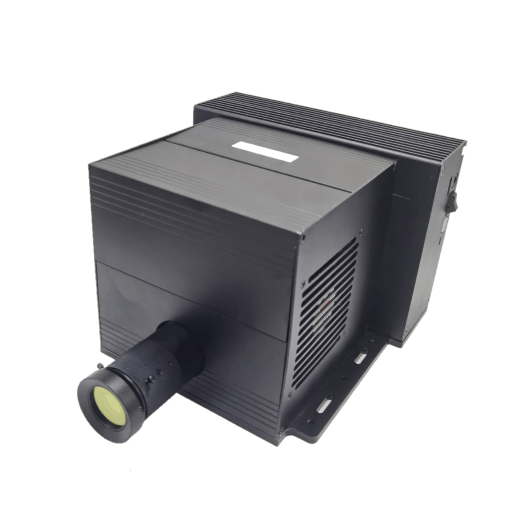Abstract The advancement of micro- and nanostructuring techniques in optics is driven by the demand for continuous miniaturization and the high geometrical accuracy of photonic devices and integrated systems. Here, UV-LED projection photolithography is demonstrated as a simple and low-cost approach for rapid generation of twodimensional optical micro- and nanostructures with high resolution and accuracy using standard optics only. The developed system enables the projection of structure patterns onto a substrate with 1000-fold demagnification. Photonic devices, e.g., waveguides and microring resonators, on rigid or flexible substrates with varied geometrical complexity and overall structure dimensions from the nanometer to centimeter scale were successfully prepared. In particular, high-resolution gratings with feature sizes down to 150 nm and periods as small as 400 nm were realized for the first time by this approach. Waveguides made of doped laser active materials were fabricated, and their spontaneous emission was detected. The demonstrated superior performance of the developed approach may find wide applications in photonics, plasmonics, and optical materials science, among others.
IntroductionDriven by the increasing demand for miniaturization andcompact integration of production, advanced fabricationtechniques based on lithography have been developedextensively in the past few decades to realize optical andphotonic devices with downsized dimensions and highaccuracy. To date, highly accurate micro- and nanoele-ments, e.g., waveguides1–3, gratings4–6,ringresonators7–9,splitters10,11, and optical switches12–14that constituteadvanced integrated circuits or networks, can be preparedby two-photon lithography15–17, electron beam litho-graphy18–20, ion beam lithography21,22,ornanoimprintlithography23,24on a laboratory scale. Fabrication systemsbased on thefirst three methods exhibit excellent perfor-mance in high-quality and high-resolution structuring, butthey are significantly expensive and limited by lowthroughput. Nanoimprint lithography enables high-resolution structuring with low cost and high throughput.However, the precise molds required for replication limititsflexibility and necessitate additionalfinancial and timeinvestments25. Another technique, extreme ultraviolet(EUV) lithography, produces very high-quality and high-resolution structures. The state-of-the-art smallest featuresize is below 10 nm26,27. However, this technique is mainlyused for mass production of microelectronic integratedchips, and the commercial EUV lithography system costsmore than a hundred million euros, which is extremelyexpensive. Laboratory-scale optical contact lithography28,29and projection photolithography30–33are also beingdeveloped for micro- and nanostructuring, but thesemethods have only achieved resolutions at the micrometerscale thus far. In addition, optical contact lithographyrequires the use of a contact mask aligner that is expensiveand the resolution and precision of the pattern on a pho-tomask are the same as those produced on the targetstructure, since the pattern is directly transferred onto the
substrate without demagnification. The currently availableprojection lithography usually employs a mercury lamp asthe light source, in which case a bulky cooling system isrequired and a higher cost results.To improve the production capabilities of optical pro-jection lithography at the micro- and nanoscale and reducethe cost and size of fabrication instruments, we present UV-LED microscope projection photolithography (MPP), afabrication approach using light to transfer a pattern to asubstrate by use of a standard microscope objective; this is apowerful alternative technology for the fabrication of high-quality photonic components. A simple and low-cost UV-LED MPP setup was developed as an advancement, and itscapabilities in the rapid and precise generation of high-resolution 2D micro- and nanostructures are demonstrated.In the developed MPP setup, tube lenses were implementedand combined with the objective to create an infinity-corrected optical system for the purpose of minimizingimaging aberrations, which significantly affect the quality offabricated structures. Autofocus and stitching processeswere developed to enable automation of the system andrealize large-area structuring. With this fabricationapproach, high-resolution diffractive gratings with featuresizes down to 150 nm and periods of 400 nm were realizedfor thefirst time. Moreover, large-area microstructures atthe millimeter and centimeter scales, elements on both rigidandflexible substrates, and microstructures made of pho-topolymers with embedded laser active material, which havenot been reported, were successfully fabricated. In parti-cular, the use of polymers doped with laser active materialopens the route to the creation of novel active photonicdevices for various applications. The obtained results clearlyshow that the developed MPP approach is a powerful toolfor rapid,flexible, and high-resolution optical fabrication.ResultsUsing the developed MPP approach, optical micro- andnanostructures were realized by following three main steps,which cover the procedures from structure design to fabri-cation of the structures on substrates. Two setups com-prising Tessar projection photolithography (TPP) and MPPwere developed for the preparation of patterned chromiumphotomasks and the fabrication of the desired structures,respectively. A detailed description and schematic illustra-tions of both systems are given in the Materials and methodssection. To demonstrate the capabilities of the approach,various micro- and nanostructures with different geome-tries, dimensions, substrates, and materials were produced.Single-mode straight and crossed waveguidesSingle-mode waveguides with varied geometrical com-plexity were fabricated in afirst step (Fig.1), whichcontains a group of single-mode crossed waveguides withdifferent geometries and feature sizes. The structures aremade of a self-synthesized low-shrinkage organic–inorganichybrid photosensitive material34and were fabricated on a


Share:
Understanding Structured Light and 3D Scanning
Sicube UV Dlp projector written by CHAT GPT